
Agapanthus africanus, or the African lily, is a flowering plant from the genus Agapanthus found only on rocky sandstone slopes of the winter rainfall fynbos from the Cape Peninsula to Swellendam. It is also known as the lily-of-the-Nile in spite of only occurring in South Africa.

Gloriosa is a genus of 12 species in the plant family Colchicaceae, and includes the formerly recognised genus Littonia. They are native in tropical and southern Africa to Asia, and naturalised in Australia and the Pacific as well as being widely cultivated. The most common English names are flame lily, fire lily, gloriosa lily, glory lily, superb lily, climbing lily, and creeping lily.

Babiana is a genus of geophytes in the family Iridaceae with 93 recognized species as of March 2022. The leaves consist of a stalk and a blade that are at an angle to each other. The leaf blades are entire, laterally flattened and pleated, and often hairy. Each individual flower is subtended by two hairy or smooth bracts that are green in most species. The outer bract is often the largest of the two. In most species the bracts have a dry, brown tip, but in a few species it is entirely green or entirely dry when flowering or the outer bract is translucent and has a papery texture. The inner bract is forked or split all the way to its base. Each flower is without a pedicel, with six tepals that are merged at their base into a tube and form a perianth that is mirror-symmetrical in most species, with three anthers implanted where the perianth tube widens and that are, in almost every species, clustered at one side of the style. The style has three branches that widen towards the tip and the ovary is inferior. Flowers occur in almost every conceivable colour, many have markings on some of the tepals, and few star-symmetrical flowers have a centre that strongly contrasts with the free part of the perianth. The majority of these species are endemic to the west and southwest of South Africa, and southwestern Namibia, but one species occurs elsewhere in Namibia and South Africa and another species can be found in Botswana, Namibia, South Africa, Zambia and Zimbabwe. The genus name is derived from the Dutch word baviaan, referring to the Chacma baboon, Papio ursinus, that consumes the corms of plants in the genus. The genus is called bobbejaantjie in Afrikaans, meaning small baboon.

Lachenalia reflexa is species of the genus Lachenalia endemic to lowland areas near Cape Town, South Africa.

Wachendorfia is a genus of perennial herbaceous plants that is assigned to the bloodroot family. The plants have a perennial rootstock with red sap. From the rootstock emerge lance- or line-shaped, sometime sickle-shaped, pleated, simple leaves set in a fan, that are flattened to create a left and right surface rather than an upper and lower surface. The leaves die when the seeds are shed in three of the species, and are perennial in one species. The rootstock also produces flowering stems annually that carry a panicle of zygomorphic, yellow or yellowish flowers in two distinct forms, one with the style and one stamen bent to the right and two stamens to the left, and vice versa. The fruit opens with three valves and each contains a single, hairy seed. All species only occur in the fynbos biome in the Cape Provinces of South Africa.
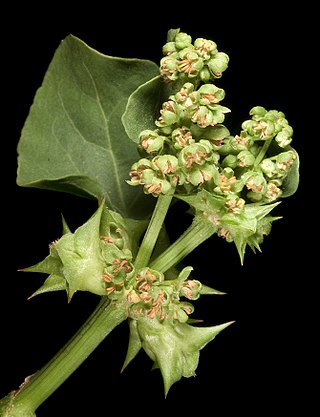
Rumex hypogaeus, commonly known in English as southern threecornerjack, devil's thorn, or double gee, is a herbaceous plant of the Polygonaceae. It is native in South Africa and is an invasive species in Australia, Texas in the USA & Pakistan.

Moraea aristata is a species of flowering plant in the family Iridaceae. It is referred to by the common names blue-eyed uintjie or Blouooguintjie in Afrikaans.It is endemic to the city of Cape Town and is considered to be critically endangered.
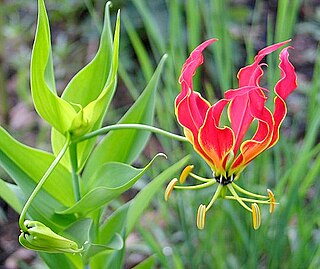
Gloriosa superba is a species of flowering plant in the family Colchicaceae. Common names include flame lily, climbing lily, creeping lily, glory lily, gloriosa lily, tiger claw, the Poison Plant, agnishikha and fire lily.

Gladiolus alatus is a species of geophyte from South Africa. Common names include painted ladies, king kalkoentjie and kipkippie. Kalkoentjie means "little turkey" in Afrikaans and refers to the shape of the flower, which resembles a turkey's wattle. It is popular as a garden plant and an important part of the cut flower industry in parts of the world on account of its large and showy orange flowers.
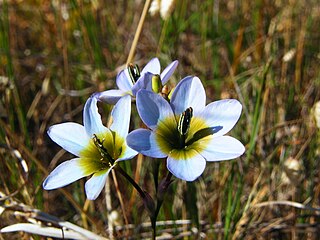
Ixia monadelpha, also known as the pied kalossie or bontkalossie, is an endangered species of geophyte found in wet sandy flats in the southwestern Cape of South Africa.
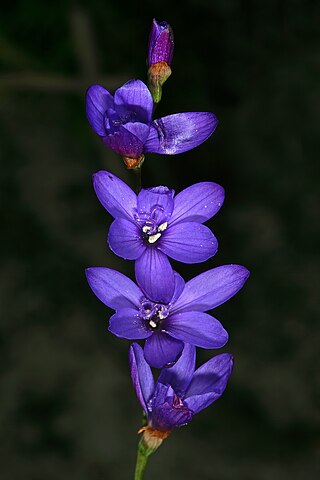
Geissorhiza aspera, also known as the blue satin flower or blou sysie, is a geophyte from South Africa.

Romulea sabulosa is a perennial geophyte that is assigned to the family Iridaceae. It has a few grooved thread-like leaves, and relatively large burgundy red trimerous flowers, reminiscent of crocus flowers, with yellow to light greenish with black markings and stamens with light green free filaments. It only occurs on sandy clay on renosterveld west of Nieuwoudtville in the Northern Cape province South Africa. It is called satynblom in Afrikaans.

Romulea monadelpha is a herbaceous perennial geophyte in the family Iridaceae native to South Africa. It has a small corm in the soil, a few thread-like leaves, and trimerous dark red flowers with elaborate markings on the inside near the bottom of the flower. It is called karoo satynblom in Afrikaans.

Cyrtanthus ventricosus, commonly called fire lily, is a small deciduous, bulbous plant reaching a height of 100–250 mm (3.9–9.8 in). It is in the amaryllis family, Amaryllidaceae, and is found along the Cape Fold Mountains from the Cape Peninsula, Western Cape, to the Kouga Mountains, Eastern Cape in South Africa.

Wachendorfia thyrsiflora, the marsh butterfly lily, is a plant species of 0.6–2.5 m (2.0–8.2 ft) high when flowering, that has been assigned to the bloodroot family. It is a large to very large evergreen perennial plant with an underground rootstock with clusters of roots produced at the nodes. The rootstock has a distinctive red colour that results from so-called arylphenalenone pigments. The sturdy, entire and broadly sword-shaped leaves have laterally flattened and pleated leaf blades. The golden yellow flowers are set a dense cylindrical panicle on a tall firm stalk. Flowering occurs from spring until mid-summer.
Juncus capillaceus is a rush species native to South America, but has been introduced to other parts of the world.
Senecio ruwenzoriensis is an African species of plant. While it is widely distributed, it seems to be highly localised in this range.
Cheiridopsis umdausensis is a species of succulent plant from South Africa.
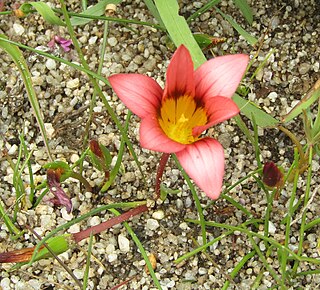
Romulea hirsuta is a geophyte from South Africa. It has pink flowers with dark marks at the edges of the yellow center.

Lachenalia unifolia, the banded viooltjie, is the most common Lachenalia species in the Cape Floristic Region of South Africa.

















